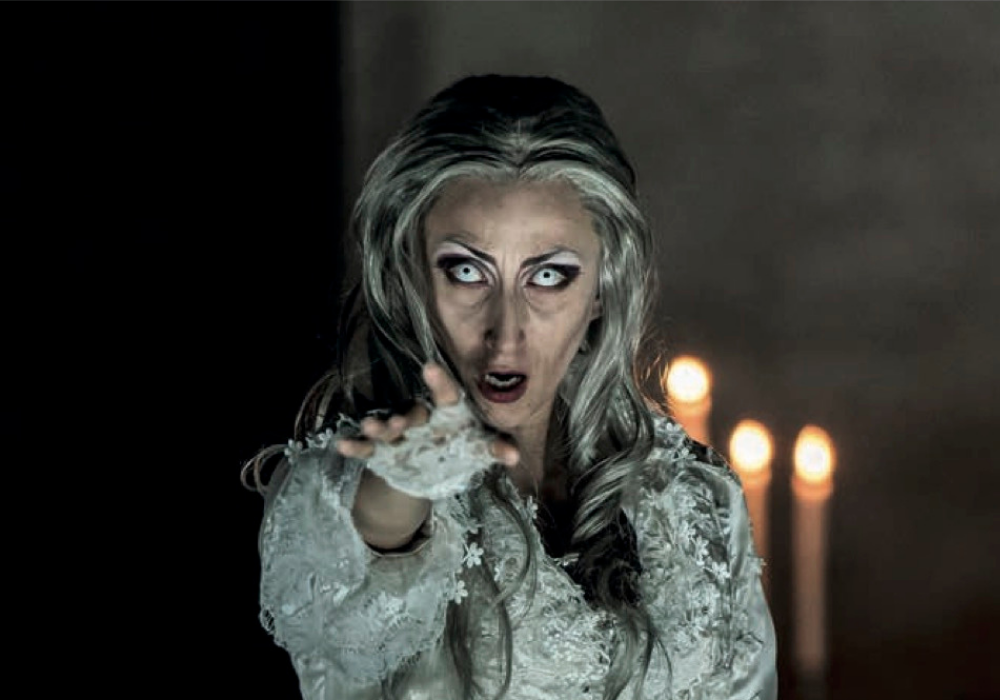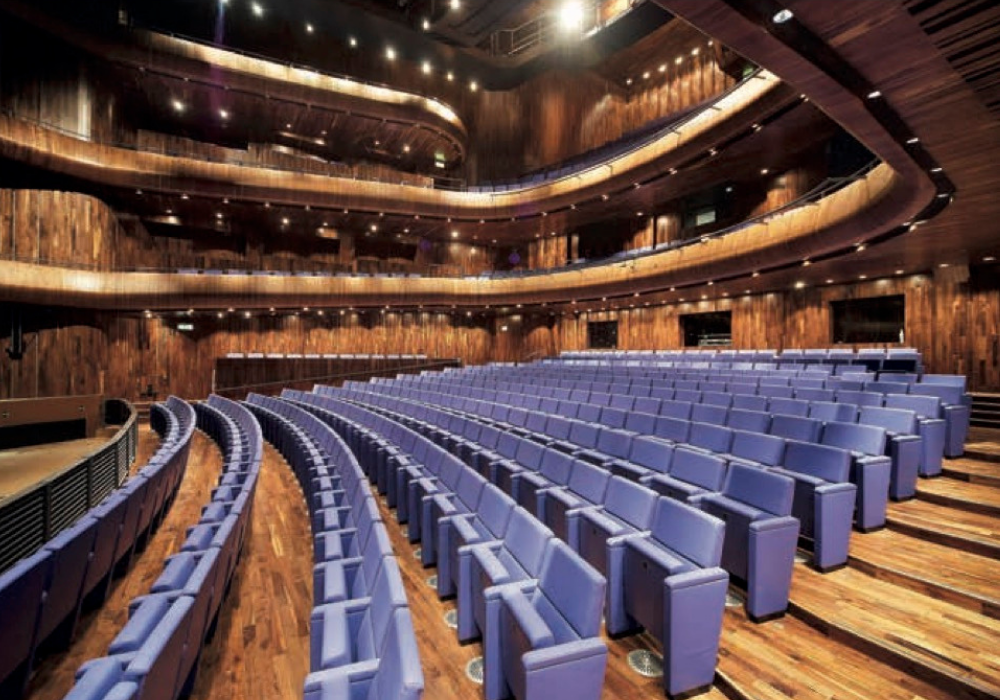
The history of Wexford Festival Opera, 1951–2021|Four Courts Press|ISBN:978-1-84682-997-0|€36

“…belief, courage, ingenuity, determination and the occasional minor miracle has seen it pull through the most testing of times. The current challenges will be no different, but fundamentally, we still believe in miracles at Wexford.”
—Karina Daly talks opera, the magic of Wexford, and how she came to write a history of the opera festival.
Starting with opera
There are many well known operas that people might enjoy as their first foray into the world of opera. In terms of comic opera, Il Barbiere Di Siviglia (The Barber of Seville) is as good a place to start as any.
However, I would challenge any novice opera goer to come to Wexford to share in the Festival experience. They may never again get the opportunity to hear an opera that they could hear in Wexford. And it might just be a magical experience.

First opera, first connections
I attended my first main stage opera in 1999. The opera was a Polish one by composer Stanislaw Moniuszko – Straszny dwor (loosely translated as The Haunted Manor).
I was in my early twenties at the time and it was a thrill to get to go to the opera. It was in the old Theatre Royal then.
I play the violin in an orchestra, so, for me, going to see an opera was all about the music in the orchestral pit, as opposed to the singing on the stage.
It was a while before I started to really appreciate excellent singers. Sometimes, an operatic production just lands – an example of this for me would be Silent Night by Kevin Puts which was performed in Wexford in 2014.

Silent Night
It was a European premiere of the opera and marked the centenary commemoration of the Great War of 1914.
Nearly one thousand Wexford men had lost their lives in the war – forty in a single day alone on 19 October 1914. A century later, to the week, Wexford staged Silent Night in the Opera House.
There was nearly a minute of silence at the end of the opera before the audience applauded the moving performance.


Early vision
Tom Walsh had the vision of creating an opera festival in Wexford—back when it was a town of 11,000 people. Tom Walsh was a local medical doctor with a lot of ambition and a love of opera.
Having established the Wexford Opera Study Circle at the end of 1950, he published a letter in early 1951 in the national press outlining the plan to create a Festival of Music and the Arts in Wexford.

Ambitious
He had a target of securing 500 guineas in subscriptions in order to get the project off the ground. He didn’t get enough subscriptions! He received only 200 guineas. And there the story might have ended. Walsh himself recalled that:
‘To a man everybody voted against it, on the perfectly sensible grounds that there was obviously insufficient interest in the project to make it a success. Whereupon, I decided we would hold the Festival anyhow’.
It’s remarkable to think that even the London Times had published word of this Festival before it had even taken place, describing it as ‘the most ambitious venture of its kind in years’.
A quiet confidence
In the aftermath of the first Festival in 1951, the Boston Globe reported that the Festival was deemed to be ‘the most constructive cultural step taken by the nation since the founding of the Abbey Theatre’ 50 years previously. And yet, 5 months earlier, they had nothing but 200 guineas and a gramophone.
You know, it sounds strange, but there was a quiet confidence in Wexford that the Festival would continue year on year after that.

With no money, a wholly unsuitable theatre with no dressing rooms and an inadequate orchestral pit, these were seen as minor operational matters that could not get in the way of putting on opera in Wexford.
As the New York Times concluded ‘Like its founder, the festival is indeed somewhat eccentric, a mixture of fashion and familiarity, high professional quality and endearingly homespun’.
Tiny streets and big hearts
There is definitely something magical about Wexford town in the autumn during the Opera Festival.
It is a very welcoming place and the fringe events that take place in the town – singing and swinging pub competition, art exhibitions, decorative shop window displays and pop-up music events – all add to the festival atmosphere that visitors find so appealing.
The streets are still narrow and filled with the same atmosphere, and the new Opera House is tucked away on one of these narrow side streets, where the old Theatre Royal used to be. It takes everyone by surprise when they visit the Opera House for the first time.
The History of Wexford Festival Opera
I wrote the book because it’s a story that deserves be told. There have been so many big changes and challenges for the Festival over the last number of years, that I wanted to record them.
I also wanted to create something for the 70th anniversary, to keep the Festival alive in people’s minds. This time last year, it wasn’t clear what the future held – all arts organisations were in the same boat. So I had the chance to reflect on this, I had access to the archival material that I needed to write the full account of the Festival, and I went ahead and put pen to paper.
It is an extraordinary story and an extraordinary achievement. I wanted to portray the many ups and downs of a venture like this. I suppose I wanted to make sure that people didn’t take it for granted.
Even a very successful event like this is fragile when not supported. The Covid-19 pandemic taught us this in a very cruel way.
Photography
I had the privilege of working with Sir Clive Barda, who helped me to select some of the more recent images from his collection. I also sought help from David Agler, who was the Artistic Director of Wexford Festival Opera for many years, as I was interested in which operas he had a particular affection for.
The transition to sharper, colour images over the years was also interesting for me and Karen Carty of Anú Design did a fantastic job in presenting the old and new images seamlessly side by side.
Favourite images
There is an image of a number of the opera singers, including Nicola Monti, walking through the Bullring in Wexford in 1954. The old buildings, the statue of the Pikeman, and the singers that are walking with such composure makes for a beautiful image, and one that has always resonated with me

Annunziata Vestri in Guglielmo Ratcliff, 2015
Annunziata Vestri in Guglielmo Ratcliff, 2015 is another favourite. The opera production was so visually appealing, that there were many photos that I would have liked to have used from this opera alone.
Sir Clive Barda has a rare talent of capturing the essence of a scene – not easy in opera.

The Factory Singers doing Flashmob on the Quay in Wexford in 2020.
I was on the quay that morning as the sun came up and I watched the performance of the Factory singers. It was a beautiful experience and captured perfectly by Padraig Grant, photographer.

Then transformation of the Opera House
The building of the National Opera House on the site of the old Theatre Royal is probably the greatest achievement to date of Wexford Festival Trust – the first purpose-built opera house in Ireland.

The vision for this state-of-the-art facility was set years ahead of its opening in 2008.
After years of hard graft by members of the Festival Board and the late Jerome Hynes, the Festival’s Managing Director, the government announced in 2005 that it would invest €26 million in the building of a new Opera House in Wexford. The Wexford Festival Board had a target of €7 million to raise locally, through sponsors and private donors.
Element of Surprise
The reinstated terraced building façade on the outside camouflaged the new building perfectly and succeeded in maintaining the element of surprise that is so characteristic of the old Theatre Royal, tucked away on the narrow side street.

It features an auditorium for 780 people, a multi-purpose ‘black-box’ performing space for 175 people and several smaller rehearsal spaces.
The decision to clad the auditorium walls in walnut panelling was taken with the acoustic in mind, but the overall effect of the panelling is also beautiful in the auditorium.
The exposed lighting bridges overhead complete the impression of a large cello, the wood portraying the body of the instrument and the lighting bridges portraying the strings. The fly tower externally is clad in copper, hence the distinctive appearance on the Wexford skyline.
Remarkably, the building was delivered on budget at €32 million and on schedule. It was handed over to Wexford Festival Opera on 1 August 2008.
It picked up a number of awards, including an Irish Times Theatre Award for special achievement, an Opus Architecture and Construction Award, a Royal Institute of Architects in Ireland (RIAI) Best Cultural Building award, and a coveted award from the Royal Institute of British Architects for architectural excellence. And finally, it became the National Opera House.
A bright, international light
From the very first year, the Festival managed to attract international attention. Tom Walsh had invited Sir Compton Mackenzie to be the Festival’s first President. He had also contacted the famous English conductor Sir Thomas Beecham to discuss the project in its first year.

He convinced Radio Éireann to make its orchestra available for the opera performances during the festival. Walsh had an ability to portray the passion of what he was trying to achieve, and he encouraged others to get involved and provide support.
From Tom Walsh’s time as Artistic Director, Wexford Festival has always been praised for the ability to attract excellent singers, some of them at the beginning of their careers who have gone on to become internationally-acclaimed in the world of opera.
The quality of the cast and the productions over 70 years has ensured that, remarkably, Wexford continues to hold a position of international prominence among opera Festivals across the world.
The future for Wexford Festival Opera
There is a vulnerability for Wexford Festival Opera, similar to every cultural and arts organisation that sustains itself from year to year.
However, Wexford has built an incredibly resilient organisation over many years. It has dealt with many significant setbacks and has managed to keep thriving and somehow finds the money each year to make ends meet.

This is in no small part due to the donors and Friends of the Festival, who have been a constant support. Obviously the main sponsors are the Arts Council, without whom the Festival could not continue, and also Wexford County Council. But the private donors, sponsors and friends have been very important to Wexford and will continue to play a significant part in the future of the organisation.
The Wexford community believes in the Festival and it is a crucial part of the Wexford calendar each year.
As I outlined in the conclusion of my book: ‘Remembering the sentiments of Bernard Levin, the Festival was, and is, built to last. Throughout its history, Wexford Festival Opera has faced many challenging times.
On each occasion, belief, courage, ingenuity, determination and the occasional minor miracle has seen it pull through the most testing of times. The current challenges will be no different, but fundamentally, we still believe in miracles at Wexford.













